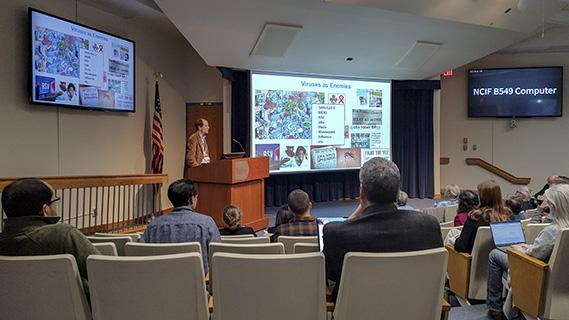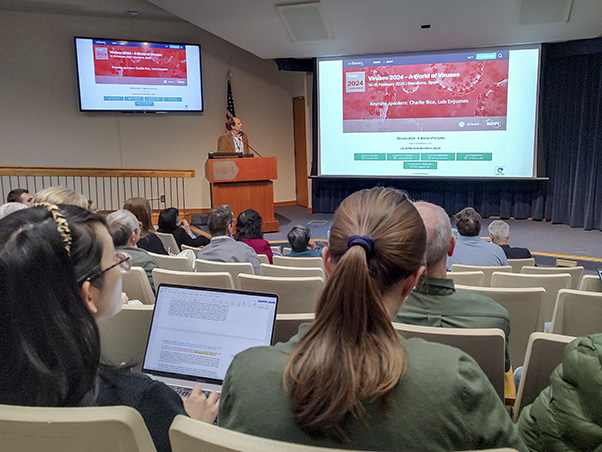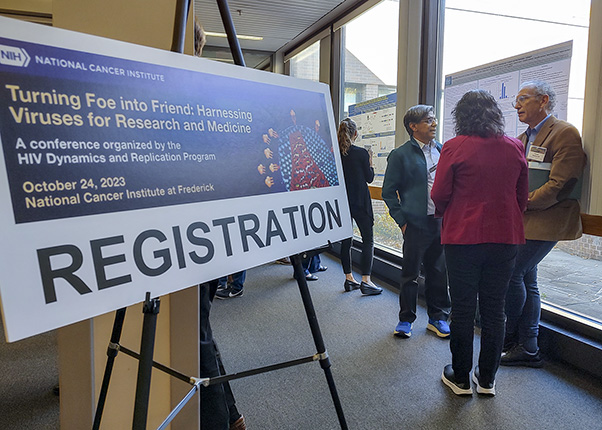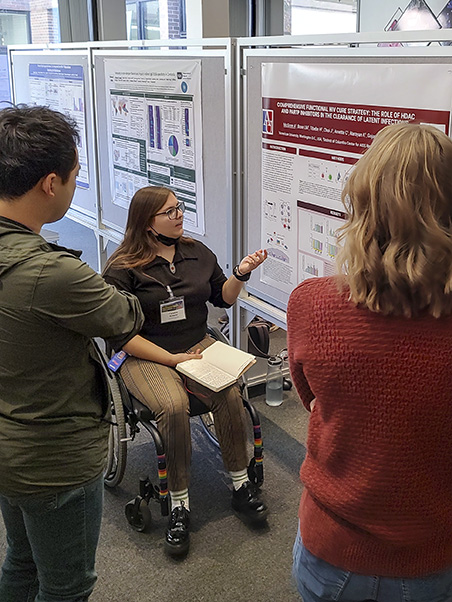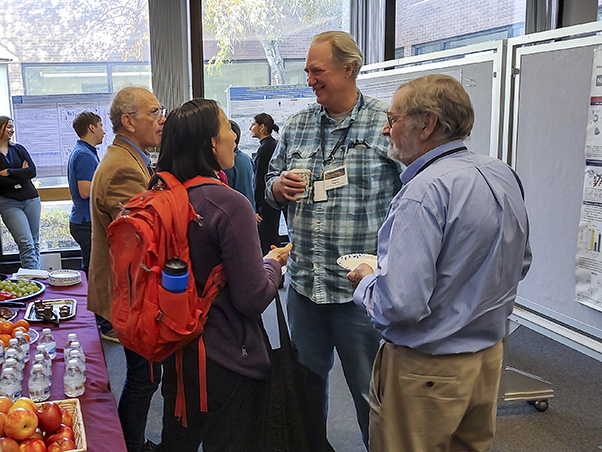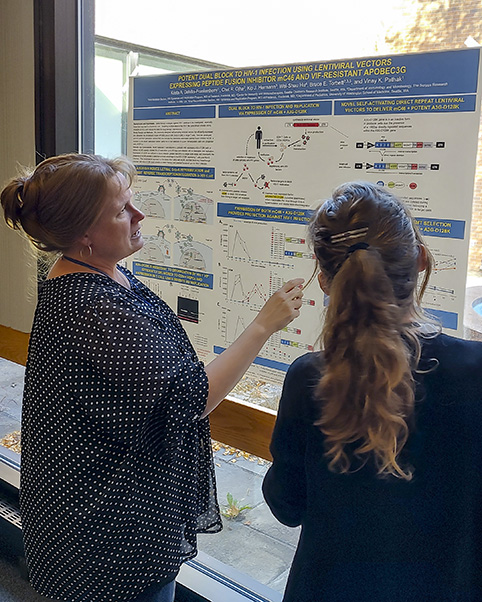Viruses are often regarded as villains in the story of humanity, but what if they didn’t always have to be? What if these microscopic invaders could serve as our allies instead—for instance, helping us treat cancer, protect against infections, and kill drug-resistant bacteria?
This isn’t wishful thinking. They already do, and scientists are exploiting them to help us further.
Last year’s HIV Dynamics and Replication Program conference at NCI Frederick, “Turning Foe into Friend: Harnessing Viruses for Research and Medicine,” provided a peek behind that curtain. Several scientists presented their research on turning viruses into tools.
The event drew a crowd and aligned with NCI’s interest in virology: viral infections affect tumors, and understanding viruses both as invaders and tools can lead to better immunology and treatment for cancer and other diseases.
The HIV DRP’s Terri Burdette and Anneliese Norris, Ph.D., organized the conference. A recording of the presentations will be available via the program’s website. Highlights from the event are below.
Poliovirus to Prime the Immune System Against Cancer
Matthias Gromeier, M.D., of Duke University School of Medicine, has set his sights on glioblastoma, a common and often-fatal brain cancer. He explained that his team is combating the aggressive malignancy with PVSRIPO, a modified poliovirus he developed in 1996 and for which he scaled up manufacturing in partnership with NCI and the Frederick National Laboratory.
The modifications make PVSRIPO incapable of killing cells and causing polio, unlike a normal poliovirus. (It has already undergone extensive safety testing in multiple clinical trials in humans, including in children with brain tumors). But it can still infect cells, especially macrophages and dendritic cells, immune cells that sense dangers and respond with coordinating immune reactions.
This is what makes PVSRIPO useful against cancer, Gromeier said. Infecting these immune cells activates them in a way that stimulates their capacity for taking up tumor antigens, presenting them to white blood cells called T cells, and priming cell-killing, antitumor responses from the T cells.
Gromeier’s team is planning a new clinical trial with an innovative treatment regimen. Traditionally, viral agents such as PVSRIPO were infused directly into the central core of brain tumors—“horribly necrotic, hypoxic, under-perfused tissue where immune responses are unlikely to occur,” Gromeier called them after the conference—but his team has already shown that rarely works well.
Instead, they plan to remove the tumor and subsequently inject PVSRIPO into the surrounding brain tissue that contains infiltrating tumor tissue. They anticipate that immune cells in or infiltrating this tissue will be much more appropriate targets for PVSRIPO’s unique stimulatory properties than immune cells in the tumor core.
“Our approach in neuro-oncology and brain tumors is exciting because it makes sense from a basic immunology standpoint,” Gromeier said. “We’re not targeting the tumor anymore. We’re targeting the tumor-relevant immune system in the brain.”
Humans as Living Bioreactors
Sarah Wootton, Ph.D., of Ontario Veterinary College, brought an inventive idea to the conference. Manufacturing protective antibodies in an industrial bioreactor can be challenging, she said, but the human body makes its own antibodies in response to invading pathogens. Ergo, people can be their own bioreactors.
Monoclonal antibodies are an important treatment for viruses for which we lack licensed vaccines or antimicrobials. Unfortunately, most provide only short-term protection and often require frequent readministrations.
Wootton’s research, however, aims to circumvent that obstacle by using a person’s existing biological functions to “manufacture” antibodies in their own body. Her work uses adeno-associated virus (AAV), an efficient vector for transferring genes. AAVs have a proven safety record in hundreds of clinical trials and FDA-approved gene therapies.
Her group is developing low-dose AAV infusions that can deliver the genetic recipes for a host to generate antibodies that last long term. So far, the results have been encouraging. She reported findings from several studies in which immunized animals developed sustained, highly protective antibodies to deadly pathogens like Ebola virus and Marburg virus.
“The idea that you can take a virus and manipulate it to do good things is what really drives me,” Wootton said after the conference.
The data suggest that the method is safe and doesn’t cause detrimental effects. Still, just in case, Wootton’s team is also engineering a “kill switch” treatment that could be used to halt AAV-mediated antibody expression in the recipient’s body.
After the conference, she also spoke of using AAVs for other health challenges, such as surfactant protein B deficiency in newborns. This rare condition causes babies’ lungs to stick together and fail. It’s invariably fatal within a year of birth.
Wootton’s team has developed an AAV that can deliver the molecular script needed for the body to produce the protein, which could let the lungs function properly again. In laboratory tests, mice with the deficiency that received the treatment had their lung function restored and lived much longer than untreated mice.
“We don’t know how long it’s going to work in a human patient, but they would immediately be put on a transplant list. So even worst-case scenario, we could use this as a bridge to [lung] transplantation,” Wootton said, calling the research “exciting.”
Altering B and T Cells
Jennifer Brudno, M.D., of NCI, and Michael Farzan, Ph.D., of Harvard University, had come to talk about immune cells.
Brudno studies chimeric antigen receptor (CAR) T-cell therapy, a method of modifying a cancer patient’s own white blood cells to attack their tumors. Treatments are effective against some cancers, but they often carry unpleasant or toxic side effects in the patient’s nervous system, she said.
To address the issue, she’s using viral vectors to modify specific parts of the cells’ genes that drive these side effects. Early studies in humans have shown these new CAR T cells are less toxic.
Farzan, meanwhile, has worked to modify the genes in B cells—a type of immune cell responsible for making antibodies—to create better antibodies against viruses. Unlike trying to engineer antibodies in a laboratory, a complex and sometimes unsuccessful process, B cells are natural antibody factories that can do the job better, he said.
His team has studied the genetic modifications and resulting antibodies in the context of SARS-CoV-2 and HIV, with meaningful results. He said the door is open to learn more about better antibodies, better vaccine models, and long-standing biological questions. CAR B-cell therapy could eventually be possible and tested against viruses.
Vectors Have More Potential
Nancy Sullivan, Sc.D., of Boston University, is researching gene vectors to adjust how the immune system responds to certain viruses, especially Ebola virus, she said. Her group performed preclinical studies with a DNA-based vector followed by a harmless adenovirus booster to condition the immune system.
Their work has revealed much about the immune response to Ebola, highlighting that T cells can be a major contributor to defense against lethal infection. Sullivan’s team has also fine-tuned the vectors to learn more about booster schedules for better protection.
Klaus Früh, Ph.D., of Oregon Health and Sciences University, said his group is working to leverage cytomegalovirus as a vector, similar to AAVs. They’ve modified it to deliver information from another virus to the recipient’s cells, thereby stimulating a protective response like a vaccine.
His group used a cytomegalovirus vector combined with noninfectious simian immunodeficiency virus (SIV) fragments to treat nonhuman primates living with SIV. Encouragingly, the recipients were functionally cured of SIV over time, Früh said. He added that a similar approach may be useful for human-specific viruses. His team has identified components of the vector to modify for application in humans.
Virus-Killing Bacteria as Organic Antibiotics
Robert “Chip” Schooley, M.D., of University of California, San Diego, brought bacteriophages to the conversation. These are viruses that infect and kill bacteria, which he presented as a means for treating antibiotic-resistant bacterial infections. He related the now-published story of a fellow professor, Thomas Patterson, Ph.D., who nearly died from one such infection but recovered after being treated with phages specific to the bacteria.
Schooley stressed that, despite the challenges to using phages, they have tremendous potential, especially given that they’re abundant in nature. They could be useful in an era of growing antibiotic resistance and ought to be approached—wisely—as living antibiotics, he said.
A Close-up on Genetics
David Largaespada, Ph.D., of University of Minnesota, has been working with transposons, pieces of DNA that move to new places within a cell’s genome. The way they do this is similar to how retroviruses insert their DNA into an infected host, he said.
Transposons’ presence can create important or disease-causing mutations. For Largaespada’s team, that makes them useful for understanding cancer. The group has engineered one, called Sleeping Beauty, to create mutations in laboratory models. From there, they can monitor whether tumors form. If one does appear, he explained, his group can analyze the DNA to identify specific mutations contributing to the cancer.
John Coffin, Ph.D., of Tufts University, concluded the conference with a conceptual talk: how artifacts of ancient viral DNA help humans against viruses today. Human DNA is full of pieces of genes from past retrovirus infections—about 60,000 of them. Far from being useless, these relics are important parts of human immunity, he said.
Coffin explained that this old viral DNA improves our cells’ ability to deal with attacks from related modern viruses. In some places, these ancient genes have slightly altered the genetic recipe for the molecules on the surface of our cells, such that certain present-day viruses can’t enter. Elsewhere, the viral DNA gives our cells extra biological machinery to intercept and dispose of viruses that have broken in.
Like the rest of the conference, it was a potent reminder of the good that viruses can sometimes bring.
Samuel Lopez leads the editorial team in Scientific Publications, Graphics & Media (SPGM). He writes for newsletters; informally serves as an institutional historian; and edits scientific manuscripts, corporate documents, and sundry other written media. SPGM is the creative services department and hub for editing, illustration, graphic design, formatting, multimedia, and training in these areas.


